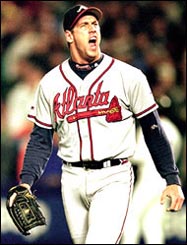Shortening the Learning Loop with Effective Communication
Note from EC: Great content from Matt Blake today. If you want to read more of Matt’s stuff, enter his name in the search box to the right of your screen, and you’ll get some of his previous writing here.
Since the Christmas pre-sale is over on the 95 MPH arm, I figured I would follow up with some more insight into the way we are working with a wide range of pitchers here at Cressey Performance.
To give you perspective, recent throwing sessions in the CP cage have included anything from minor leaguers working through controlled flat-ground drills and some simulated long-toss, to high-school guys working on velocity drills or throwing bullpens getting ready for college winter camps (for better or worse). We’ve also had a handful of players come to us following injuries as they try to build their arms back up from essentially scratch. With the wide variety of development and training that needs to take place as a result of these different situations, a strong need emerges for an effective communication style with your athlete.
For me, this is tremendously important if I expect to push a player in a sport that will have 57% of their population suffer some form of shoulder injury during a playing season (1). It seems a little absurd to think that more than half the athletes in this population will get hurt in a given season, but it’s not that crazy when you consider the fact that we’re asking the shoulder to internally rotate at velocities greater than 7,000 degrees/second and the elbow to extend at 2,000+ degrees/s during the throwing motion. If that’s not bad enough, at maximum external rotation the torque placed on the elbow is equivalent to 40lbs pulling down on the hand. When all of this is considered, it becomes clear how serious it is to actually ask an athlete to perform 80-100 repetitions of a skill at near human capacity.
Once you understand the implications of what you are requesting your player to do, the ability to effectively communicate in a manner that gains quality feedback from your pitcher becomes essential. With the tremendous amount of stress being placed on the body and no objective way to know how a particular player’s arm or body feels during practice or competition, we need to have open lines of communication to make sure each and every piece is monitored for stress.
Obviously the easiest way to gather information is to verbally ask players how they are feeling, or have them rate their fatigue on a 1-10 scale with 1 being, “My arm feels like gold”, and 10 being, “I think I just tore something”. The only problem with this is that every player will have a slightly different pain threshold and one person’s “3” may be another person’s “6.” So, if you are going to use this scale, it is important to stay on top of it and ask the player on a regular basis to calibrate the stress and watch how it slides one way or the other as they get loose or as the discomfort begins to build.

The other problem with the verbal scale is that you have to account for each player’s personality and level of competitiveness. Some players will run themselves through a wall and not think twice about the damage they could be doing. These players will under-report their pain levels in an attempt to continue throwing. With players like this, you need to resort to other means of monitoring pain levels. This is where understanding a player’s natural temperament is important. By knowing how a player normally acts, picking up subtle behavioral cues can play a large part in identifying underlying pain.
These subtle behaviors can include anything from the way they make eye contact, their facial expressions and head talk, body gestures, postural changes, etc… For example, if they grimace after throwing, shake out their arm after throws, or cross their arms when they’re standing still, then you are probably looking at some tenderness building somewhere in the arm. Mechanically, you can watch the elbow/arm slot begin to drop as they throw, the torso might become more upright, and the ball to begin to stay up in the zone more often. Velocity changes may or may not occur as well. As you begin to see one or more of these traits, it’s important to make sure you open the dialogue with the player to make them verbalize how the arm feels.
Identifying these traits and gaining trust from your pitcher to speak honestly with you about his arm’s health is the foundation for developing them to their ceiling. Once you understand how much a player can be pushed while maintaining a healthy volume or amplitude, driving the development with this same mindset becomes just as critical.
One of the problems that I believe stands in the way of a lot of players/athletes in their personal development tends to be their inability to relate to new information that you are trying to give them. It’s not that they weren’t listening or the fact that what you gave them was right or wrong, but more that it didn’t fit neatly with what they had previously learned. Different personalities, different backgrounds, different learning styles, can’t all be expected to work off the same lesson plan.
Each piece of the development needs to be looked at dynamically to see how the information is registering for the player. Two of the main things I work hard to identify early in the process are:
1) what style of learning does the player prefer?
2) where are they in their development?
Once you have the answers to these questions, you can begin to provide the necessary information in the right form for the player, so they understand why they would want to apply it and, more importantly, how they apply the new information.
By using multiple avenues to find out what the player is looking to learn or needs to learn, you can optimize the use of certain tools to flush out higher levels of performance. One of the main tools we use here is slow-motion video analysis. I find this to be very effective in getting everyone on the same page regarding what is actually happening during these highly complex movements. From there, we’ll agree on a plan of action going forward that might use lead-up drills, velocity drills, weighted baseballs, medicine balls, etc. All of these pieces help to teach something, whether it be rate of force development, knowledge of the kinetic chain, or simply a consistent rhythm and tempo in the delivery.
Obviously, the examples I’m using here are baseball related, but this can be just as easily applied to strength and conditioning, as well as other skill-specific sports. It really just comes down to the proper application of each drill or exercise with targeted work that fits the developmental needs of the athlete. If player and coach are effectively communicating, the learning loop can certainly be shortened and the sky is the limit for your athletes’ development. With that said, I hope everyone enjoys the holidays and the rest of 2009, and I certainly look forward to continuing this ongoing conversation with you guys in 2010.
References
1. Ouelette, H et al. Spectrum of Shoulder injuries in the baseball pitcher. Skeletal Radiol. 2007 Oct 3.
2. Fleisig, GS. The Biomechanics of Baseball Pitching. Spring 2008 Southeast ACSM Conference.
Matt Blake can be reached at mablak07@gmail.com.
Sign-up Today for our FREE Baseball Newsletter and Receive a Copy of the Exact Stretches
used by Cressey Performance Pitchers after they Throw!





